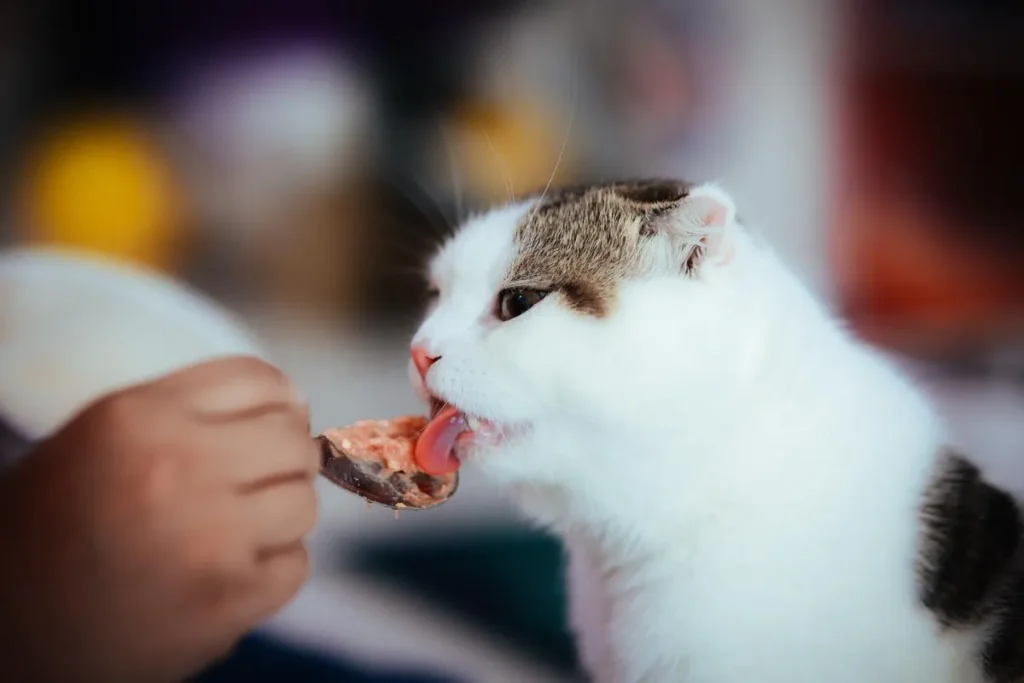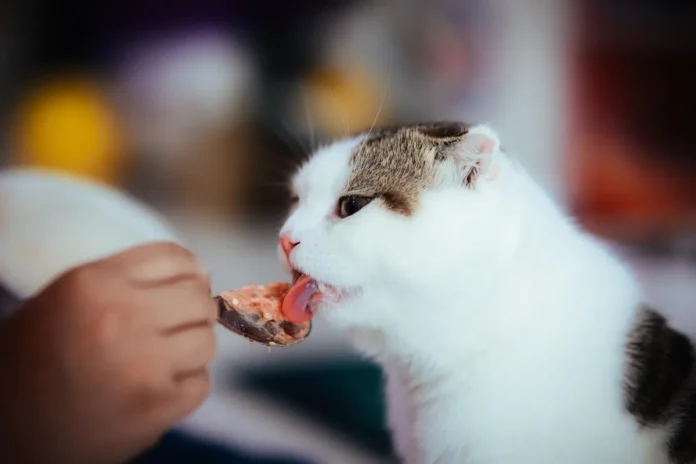Introduction
Feeding your cat a balanced diet is crucial for their overall health and well-being. While dry food is a popular choice for many cat owners, wet food can provide numerous benefits for your feline friend. In this article, we will explore the importance of feeding your cat a balanced diet and the benefits of wet food for cats.

Benefits of Wet Food for Cats
Wet food can provide numerous benefits for your cat’s health. Firstly, it can help keep your cat hydrated, as it contains a high moisture content. This is particularly important for cats who may not drink enough water on their own. Additionally, wet food can be easier for cats to digest, as it is softer and contains more protein and fat than dry food. This can be particularly beneficial for cats with digestive issues or those who are picky eaters.
Wet food can also provide a more varied diet for your cat, as it comes in a variety of flavors and textures. This can help prevent boredom and encourage your cat to eat a more balanced diet. Finally, wet food can be a great option for cats who need to lose weight, as it can help them feel fuller for longer periods of time.
Understanding Your Cat’s Nutritional Needs
In order to provide your cat with a balanced diet, it is important to understand their nutritional needs. Cats are obligate carnivores, which means that they require a diet high in protein and fat. They also require certain vitamins and minerals, such as taurine and vitamin A, which are found in animal-based proteins.
A. Protein Requirements
Protein is essential for your cat’s overall health, as it helps build and repair tissues, supports the immune system, and provides energy. Cats require a diet that is high in animal-based proteins, such as chicken, beef, and fish. The protein content of wet food can vary, so it is important to choose a high-quality brand that meets your cat’s specific needs.
B. Fat Requirements
Fat is also an important component of your cat’s diet, as it provides energy and helps support healthy skin and coat. Cats require a diet that is high in animal-based fats, such as chicken fat and fish oil. The fat content of wet food can also vary, so it is important to choose a brand that meets your cat’s specific needs.
C. Carbohydrate Requirements
While cats do not require carbohydrates in their diet, some wet foods may contain small amounts of carbohydrates, such as rice or vegetables. It is important to choose a brand that does not contain excessive amounts of carbohydrates, as this can lead to weight gain and other health issues.
Factors That Affect How Much Wet Food Your Cat Needs
The amount of wet food your cat needs can vary depending on several factors, including their age, weight, and activity level.
A. Age
Kittens and senior cats may require different amounts of wet food than adult cats. Kittens require a diet that is high in protein and fat to support their growth and development, while senior cats may require a diet that is lower in calories to prevent weight gain.
B. Weight
The amount of wet food your cat needs can also depend on their weight. Overweight cats may require less food to help them lose weight, while underweight cats may require more food to help them gain weight.
C. Activity Level
Cats who are more active may require more food to provide them with the energy they need, while less active cats may require less food to prevent weight gain.
Calculating Your Cat’s Daily Caloric Requirements
In order to determine how much wet food your cat needs, you will need to calculate their daily caloric requirements.
A. Formula for Calculating Caloric Needs
To calculate your cat’s daily caloric requirements, you can use the following formula:
(30 x your cat’s weight in pounds) + 70 = daily caloric needs
For example, if your cat weighs 10 pounds, their daily caloric needs would be:
(30 x 10) + 70 = 370 calories per day
B. Example Calculation
If you are feeding your cat a wet food that contains 100 calories per 3-ounce can, you can calculate how many cans your cat needs per day by dividing their daily caloric needs by the number of calories per can:
370 calories per day ÷ 100 calories per can = 3.7 cans per day
In this example, you would need to feed your cat approximately 4 cans of wet food per day.
How to Choose the Right Type of Wet Food for Your Cat
When choosing a wet food for your cat, it is important to read ingredient labels and avoid fillers and by-products.
A. Reading Ingredient Labels
Look for wet foods that list animal-based proteins as the first ingredient, such as chicken or fish. Avoid brands that list fillers, such as corn or wheat, as the first ingredient. Additionally, avoid brands that contain by-products, as these can be lower quality and less nutritious than whole meats.
B. Avoiding Fillers and By-Products
Fillers and by-products can be lower quality and less nutritious than whole meats. Look for brands that use high-quality ingredients and avoid those that contain fillers and by-products.
Portion Control: How Much Wet Food to Feed Your Cat
It is important to feed your cat the appropriate portion sizes to prevent overfeeding or underfeeding.
A. Recommended Portion Sizes
The recommended portion size for wet food can vary depending on the brand and your cat’s specific needs. As a general rule, adult cats should be fed approximately 3-4 ounces of wet food per meal, while kittens may require more frequent meals and smaller portions.
B. Adjusting Portion Sizes Based on Weight and Activity Level
If your cat is overweight or underweight, you may need to adjust their portion sizes accordingly. Additionally, if your cat is more or less active than average, you may need to adjust their portion sizes to provide them with the appropriate amount of energy.
Feeding Schedule: How Often to Feed Your Cat Wet Food
The frequency of feeding your cat wet food can also depend on their age and activity level.
A. Recommended Feeding Schedule
Adult cats should be fed wet food approximately 2-3 times per day, while kittens may require more frequent meals. It is important to provide your cat with a consistent feeding schedule to help prevent overeating and promote healthy digestion.
B. Adjusting Feeding Schedule Based on Age and Activity Level
If your cat is a senior or less active, they may require fewer meals per day to prevent weight gain. Conversely, if your cat is more active, they may require more frequent meals to provide them with the energy they need.
Adjusting Your Cat’s Wet Food Intake Based on Age and Activity Level
As your cat ages or becomes more or less active, you may need to adjust their wet food intake to provide them with the appropriate amount of nutrients.
A. Senior Cats
Senior cats may require a diet that is lower in calories and higher in protein to help maintain muscle mass and prevent weight gain. Additionally, senior cats may require wet food that is easier to digest, such as those that contain smaller pieces or are pureed.
B. Active Cats
Active cats may require a diet that is higher in calories and protein to provide them with the energy they need. Additionally, active cats may require wet food that is higher in fat to help support their activity level.
Monitoring Your Cat’s Weight and Health
It is important to monitor your cat’s weight and health to ensure that they are receiving the appropriate amount of nutrients.
A. Importance of Monitoring Weight and Health
Regular weigh-ins and check-ups with your veterinarian can help you identify any changes in your cat’s weight or health. This can help you adjust their diet accordingly and prevent health issues from developing.
B. Signs of Overfeeding or Underfeeding
Signs of overfeeding or underfeeding can include weight gain or loss, lethargy, and changes in appetite or behavior. If you notice any of these signs, it may be time to adjust your cat’s diet or seek veterinary advice.
Tips for Encouraging Your Cat to Eat Wet Food
If your cat is a picky eater or is hesitant to try wet food, there are several tips you can try to encourage them to eat.
A. Mixing Wet Food with Dry Food
Mixing wet food with dry food can help your cat get used to the taste and texture of wet food. Start by mixing a small amount of wet food with your cat’s dry food and gradually increase the amount over time.
B. Adding Water to Wet Food
Adding water to wet food can help make it more appealing to your cat and can also help keep them hydrated. Start by adding a small amount of water to your cat’s wet food and gradually increase the amount over time.
Consulting with Your Veterinarian About Your Cat’s Diet
It is important to consult with your veterinarian about your cat’s diet to ensure that they are receiving the appropriate amount of nutrients.
A. Importance of Consulting with a Veterinarian
Your veterinarian can help you determine the appropriate diet for your cat based on their age, weight, and activity level. Additionally, they can help you identify any health issues that may require dietary adjustments.
B. When to Seek Veterinary Advice
If you notice any changes in your cat’s weight or health, or if they are experiencing digestive issues or other health problems, it may be time to seek veterinary advice.
Conclusion
Feeding your cat a balanced diet is crucial for their overall health and well-being. Wet food can provide numerous benefits for your cat, including hydration, easier digestion, and a more varied diet. By understanding your cat’s nutritional needs, monitoring their weight and health, and consulting with your veterinarian, you can ensure that your cat is receiving the appropriate amount of nutrients to support their health and happiness.


